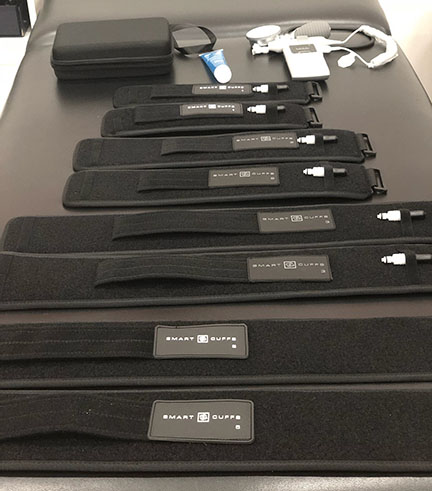What Is Blood Flow Restriction Training?
Can Blood Flow Restriction Training help improve patient recovery time following an injury? Read our post below as we discuss everything you need to know.
Blood Flow Restriction (BFR) Training is a strategy involving the brief and intermittent occlusion of arterial and venous blood flow that occurs with use of a tourniquet placed around the proximal limb of the upper or lower extremity. When performing BFR for resistance training purposes, relatively light loads of around 20-30% of 1 RM allow a person to increase strength without the stress/strain of heavy loads.

Resistance training with BFR has also been shown to increase post-exercise muscle protein synthesis and elevate growth hormone levels. It can be used to improve muscle strength, size and functional aerobic capacity in shorter amounts of time with less stress on the body than typical resistance training. Blood flow restriction training (BFRT) essentially tricks the brain-body into thinking one is performing high-intensity exercise when, in fact, the loads are much lower. BFR can also be used to reduce muscle atrophy through passive applications and by creating cellular swelling.
Who can benefit from BFR?
BFR can be useful for rehabilitation, fitness, performance training or recovery and is ideal for populations who have limitations to high mechanical loads such as those who are bedridden, casted/braced, pre/postoperative and/ or elderly. In addition to these more fragile populations, BFRT can also be used on the athletic community for performance training.
How is it used? What does a treatment session with BFR look like?
BFR can be used in different ways depending on the goals and limitations of the individual. In all circumstances, the cuff is first applied as proximal on the limb as it can be placed. Next, the loss of pulse (LOP) is calculated using an ultrasound unit to determine at what pressure a person’s pulse in that limb can no longer be detected. Lastly, a pressure in the cuff is set depending on the type of BFR to be performed.
In Passive BFR (no exercise) used to reduce muscle atrophy and stimulate capillary growth, the cuff pressure is set to 100% LOP and a patient sits with the cuff on for 5-minute increments with 5 minutes of rest in between. In Cellular Swelling and Strengthening protocols, the cuff pressure is set between 40-50% for the upper extremity and 60-80% for the lower extremity. When strengthening, the intensity should be 15-30% of a person’s 1 rep max, and 4 sets should be performed (30 reps; 15 reps; 15 reps; 15 reps) with 30 seconds of rest between each set. A total of 5-6 exercises should be performed during the treatment session with 60 seconds of rest between each new exercise while the cuff is deflated.
If the goal is not strengthening, but cellular swelling, which reduces disuse atrophy and recruits muscle fibers (perhaps someone with ROM or WB restrictions), a person should perform 5 sets of 5 minutes with a 3-minute rest in between. This can be achieved with no exercise or while performing isometrics. These are but a few of the ways BFR can be implemented into a person’s rehabilitation or strength training program.
For more information on BFR, contact us today, click here.